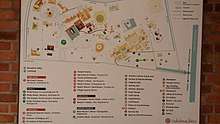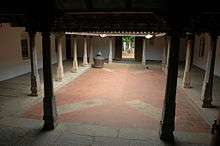DakshinaChitra
|
| |
 DakshinaChitra Location within Tamil Nadu | |
| Established | 14 December 1996 |
|---|---|
| Location | East Coast Road, Muttukadu, Chennai, India |
| Coordinates | 12°49′21″N 80°14′35″E / 12.822423°N 80.243098°E |
| Type | Heritage centre |
| Collection size | 4,220 artefacts and 1,000,000 pictures |
| Founder | Madras Craft Foundation |
| Curator | Deborah Thiagarajan |
| Architect |
Laurie Baker Benny Kuriakose |
| Website | dakshinachitra.net |
DakshinaChitra ("a picture of the south") is a living-history museum in the Indian state of Tamil Nadu, dedicated to South Indian heritage and culture. It is located 25 kilometres (16 mi) to the south of Chennai. Opened to the public on 14 December 1996, the museum was founded and is being managed by the Madras Craft Foundation (MCF). The MCF was established in 1984. Deborah Thiagarajan, an Indian art historian of American origin, governs the museum.
The museum is built on 10 acres (4.0 ha) of land taken on a 33-year lease from the Government of Tamil Nadu. Developed as a heritage village, DakshinaChitra has an array of displays depicting the life pattern of Indians in the states of South India. The exhibits portray the living beliefs of art, folk performing-arts, craft and architecture of India, in particular of South Indian traditions.
History
DakshinaChitra, meaning "a picture of the south",[1] is a heritage village where the lifestyle of South Indians is displayed based on their states. It was founded by the Madras Craft Foundation (MCF), an NGO started in 1984, by Deborah Thiagarajan.[2] Thiagarajan came to Madras (now Chennai) in 1970, and visited several rural villages in Tamil Nadu and Kerala.[3][4] She founded MCF in 1984 with the intent of preserving the regional culture and heritage.[5] In July 1991, the MCF received 10 acres (4.0 ha) of land for the project from the Government of Tamil Nadu on a 33-year lease.[6][7] In establishing the museum, cooperation was maintained between government organizations, industry and specialists in the sphere of conservation. Contributors to the museum's creation included long-term corporate donors [Ford Foundation] and the Office of the Development Commissioner for Handicrafts .[8]
Design

The museum’s plan concept was developed by architect, Laurie Baker, without charging any fee, because of his interest in rural architectural design. Baker's approach included the use of local materials and the adaptation of artisanal production methods suited to the environment. Benny Kuriakose was the architect at site.[9] Kuriakose, retained the main "spatial types and syntax", but altered the layout plan. The southern part of the museum was devoted to restoring and recreating native structures and putting them together in a sequence in the order of the states of Andhra Pradesh, Karnataka, and Tamil Nadu; a separate area was initially earmarked for the tribal people of these states but this was not put into effect.[10]
Architecture


The museum has 18 heritage houses representing the living styles of people from the states of South India such as Tamil Nadu, Andhra Pradesh, North Karnataka, Kerala and Telangana. These houses, which were actual houses that were allowed to be demolished by the original owners, were recreated by a team of architecture students, carpenters and workers. The original houses in their "vernacular style" were purchased by MCF and purchase costs varied from Rs. 50,000 for ordinary mud houses to Rs. 1.5 million for the Chettinad merchants' mansions with crafted doors and woodwork.[7]) They were then dismantled systematically under the guidance of stapathis (temple architects). The dismantled elements were transported to the museum site and recreated at the allotted space in their exact original form. Apart from recreating the homes, the roads and all other features that existed in the old village sites were recreated.[3][11] Some critics have complained that the characterization of pre-industrial village life is inaccurate, focusing too much on the Nattukkottai Chettiar, and that the site is "stamped" with "American consumerism". [12]
Collections
The artefacts in the museum reflect the daily life in the Southern States. As of 2014, there were 4,220 artefacts on display; 3,200 are art-related, and 70 pertain to contemporary subjects. Approximately 950 objects are clothing, featuring typical South Indian attire of men and women in cotton and silk fabrics.[13]
The museum contains a collection of books and journals pertaining to arts, crafts, performance, anthropology and folklore of South India. There are also 1,000,000 pictures.[13] The entire display is in the English language, and highlights the cultural aspects of Brahminical people[14] and the craft traditions of heritage homes of South India.[3]
Programs
The museum is a center for living traditions of art, folk performing arts, and crafts set up with the objective of preserving and promoting South India's heritage and culture.[15] Special programmes feature dances, crafting of necklaces, basket weaving, and puppet shows. The museum also holds workshops for training in traditional crafts such as indigo dying.[14] Potters trained at the center are issued a certificate of their skills by the regional office of the Department of the Development Commissioner (Handicrafts).[15] Classical dances such as Bharatnatyam, Mohiniyattam and Kuchipudi, and music concerts are regular events held in the large amphitheater.[16] Each year, 15,000 school children visit the museum.[17]
Grounds
.jpg)
The center occupies ten acres overlooking the Bay of Bengal, at Muttukadu, 25 kilometres (16 mi) south of Chennai, on the East Coast Road to Mamallapuram, Tamil Nadu, India.[3] The grounds include a research unit, crafts bazaar, playground, an area to hold religious functions, stone workshop, and souvenir kiosks.[18] The craftsmen demonstrate or explain how they make their wares.[16]
References
- ↑ Joseph Fernandez (23 July 2001). "A date with heritage". The Hindu Business Lines. Archived from the original on 20 March 2018.
- ↑ Krithika Reddy (21 September 2006). "'We need people with a public vision'". The Hindu. Archived from the original on 20 March 2018.
- 1 2 3 4 "Heart in heritage". The Hindu. 27 June 2007.
- ↑ "Dakshinachitra: A labour of love". Rediff. 17 March 2006. p. 2. Archived from the original on 4 March 2016.
- ↑ "Dakshinachitra: A labour of love". Rediff. 17 March 2006. p. 3. Archived from the original on 4 March 2016.
- ↑ Lakshmi Viswanathan (20 March 2000). "Fostering culture in her own way". The Hindu. Archived from the original on 20 March 2018.
- 1 2 "Dakshinachitra – A Rare Museum". Indian Holiday Pvt. Ltd. Archived from the original on 27 August 2015. Retrieved 2 February 2015.
- ↑ Fernandez 2004, p. 216.
- ↑ Madhyam 2000, p. 13.
- ↑ Guggenheim & Söderström 2009, p. 149.
- ↑ Fernandez 2004, p. 213.
- ↑ Hancock 2008, p. 246.
- 1 2 "Library and Archives". DakshinaChitra Museum Organization. Archived from the original on 28 July 2015. Retrieved 1 May 2015.
- 1 2 Programme 2004, p. 42.
- 1 2 Link & Ramanathan 2010, p. 42.
- 1 2 "Must see must do in Chennai". Dakshinachitra. India Today. 3 January 2012. Archived from the original on 17 June 2015. Retrieved 8 October 2015.
- ↑ Fernandez 2004, p. 210-11.
- ↑ Acuff & Evans 2014, p. 120.
Bibliography
- Acuff, Joni Boyd; Evans, Laura (8 July 2014). Multiculturalism in Art Museums Today. Rowman & Littlefield Publishers. ISBN 978-0-7591-2411-0.
- Fernandez, Joseph (8 December 2004). Corporate Communications: A 21st Century Primer. SAGE Publications. ISBN 978-0-7619-9746-7.
- Guggenheim, Michael; Söderström, Ola (4 December 2009). Re-shaping Cities: How Global Mobility Transforms Architecture and Urban Form. Routledge. ISBN 978-1-135-18908-2.
- Hancock, Mary E. (29 October 2008). The Politics of Heritage from Madras to Chennai. Indiana University Press. ISBN 0-253-00265-6.
- Link, Rosemary J.; Ramanathan, Chathapuram S. (16 September 2010). Human Behavior in a Just World: Reaching for Common Ground. Rowman & Littlefield Publishers. ISBN 978-1-4422-0292-4.
- Madhyam (2000). Madhyam: Issues in Communication, Culture, and Development. 15, Issues 1-2. Bangalore: Madhyam.
- Programme, United Nations Human Settlements (2004). The State of the World's Cities 2004/2005: Globalization and Urban Culture. UN-HABITAT. ISBN 978-92-1-131705-3.
External links
| Wikimedia Commons has media related to DakshinaChitra. |